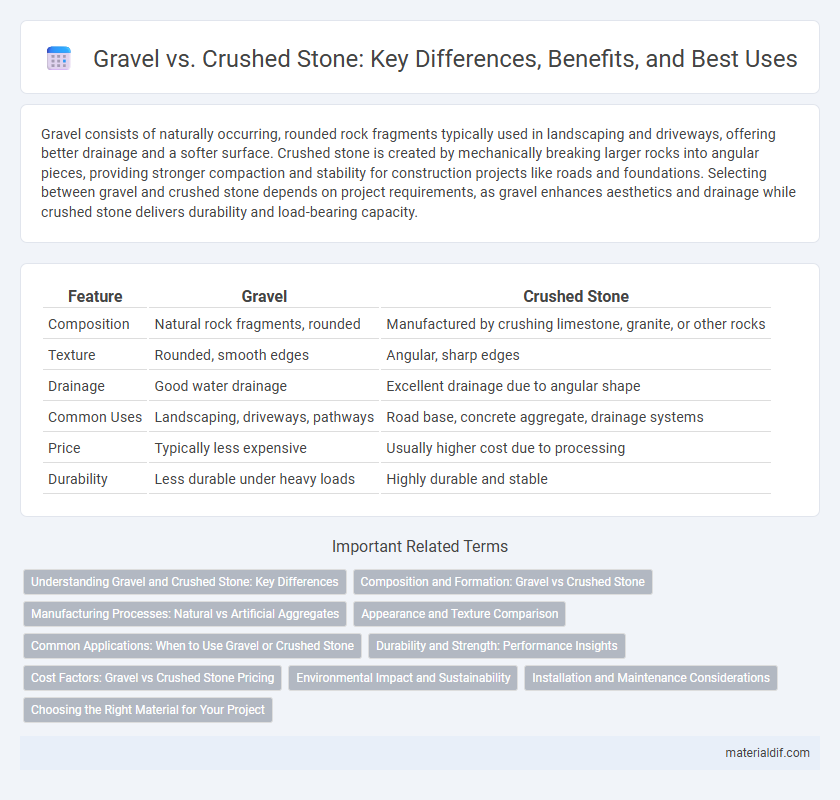Gravel consists of naturally occurring, rounded rock fragments typically used in landscaping and driveways, offering better drainage and a softer surface. Crushed stone is created by mechanically breaking larger rocks into angular pieces, providing stronger compaction and stability for construction projects like roads and foundations. Selecting between gravel and crushed stone depends on project requirements, as gravel enhances aesthetics and drainage while crushed stone delivers durability and load-bearing capacity.
Table of Comparison
| Feature | Gravel | Crushed Stone |
|---|---|---|
| Composition | Natural rock fragments, rounded | Manufactured by crushing limestone, granite, or other rocks |
| Texture | Rounded, smooth edges | Angular, sharp edges |
| Drainage | Good water drainage | Excellent drainage due to angular shape |
| Common Uses | Landscaping, driveways, pathways | Road base, concrete aggregate, drainage systems |
| Price | Typically less expensive | Usually higher cost due to processing |
| Durability | Less durable under heavy loads | Highly durable and stable |
Understanding Gravel and Crushed Stone: Key Differences
Gravel consists of naturally weathered and rounded stones, often sourced from riverbeds, while crushed stone is mechanically broken from larger rock formations resulting in angular edges. Gravel's smooth texture provides better drainage and is commonly used in landscaping and decorative applications, whereas crushed stone offers superior compaction and stability, ideal for construction and road base layers. Understanding the distinct formation, texture, and typical uses of gravel versus crushed stone helps in selecting the appropriate material for specific building and design projects.
Composition and Formation: Gravel vs Crushed Stone
Gravel consists of naturally weathered and rounded particles primarily made of quartz, feldspar, and other minerals, formed through natural processes like erosion and sedimentation in riverbeds or glacial deposits. Crushed stone is mechanically broken down from larger rocks such as limestone, granite, or trap rock, resulting in angular, sharp-edged fragments. The natural origin of gravel versus the artificial crushing of stone directly influences their texture, strength, and suitability for construction and landscaping applications.
Manufacturing Processes: Natural vs Artificial Aggregates
Gravel is a natural aggregate formed through the erosion and weathering of rocks, resulting in smooth, rounded particles. Crushed stone, an artificial aggregate, is produced by mechanically crushing larger rocks, yielding angular and sharp-edged fragments. The manufacturing process influences the texture, shape, and strength of these aggregates, affecting their suitability for various construction applications.
Appearance and Texture Comparison
Gravel typically features rounded, smoother edges with a natural, weathered appearance resulting from river or stream erosion. Crushed stone has angular, jagged edges and a rougher texture due to mechanical crushing processes, providing better interlocking for construction projects. This distinct difference in shape and surface texture influences both aesthetic appeal and functional performance in landscaping and building applications.
Common Applications: When to Use Gravel or Crushed Stone
Gravel is ideal for landscaping, drainage systems, and decorative purposes due to its naturally rounded edges and varied sizes, which provide excellent water runoff and aesthetic appeal. Crushed stone, characterized by its angular shape and sharp edges, is preferred for construction projects like concrete production, road base layers, and driveways where compaction and stability are critical. Both materials serve distinct roles, with gravel excelling in erosion control and surface applications, while crushed stone supports structural integrity and load-bearing functions.
Durability and Strength: Performance Insights
Gravel offers natural durability with smooth, rounded edges that resist weathering but may compact less under pressure compared to crushed stone. Crushed stone features sharp, angular edges that lock tightly together, providing superior strength and load-bearing capacity for construction and road base applications. For high-performance projects demanding maximum stability and longevity, crushed stone remains the preferred material due to its enhanced interlocking properties.
Cost Factors: Gravel vs Crushed Stone Pricing
Gravel generally costs less per ton compared to crushed stone due to its natural occurrence and minimal processing requirements, making it a budget-friendly option for landscaping and driveways. Crushed stone, produced by mechanically breaking down larger rocks, incurs higher costs linked to extraction, crushing, and transportation, which contributes to its increased price. Price variations also depend on factors like regional availability, material type, and project scale, impacting overall gravel and crushed stone expenses.
Environmental Impact and Sustainability
Gravel extraction often causes less environmental disruption compared to crushed stone quarrying due to less intensive mining processes and reduced energy consumption. Gravel tends to support better natural water drainage and minimizes runoff pollution, enhancing sustainability in construction projects. Crushed stone production generates more dust and waste byproducts, contributing to higher carbon emissions and environmental degradation.
Installation and Maintenance Considerations
Gravel offers easier installation due to its naturally rounded edges, which allow better compaction and drainage compared to the sharper, angular profile of crushed stone that requires more effort for leveling and stabilization. Gravel requires less frequent maintenance as its smooth texture reduces interlocking and minimizes shifting, whereas crushed stone demands regular regrading and occasional replenishment to maintain a stable surface. Selecting between gravel and crushed stone impacts long-term upkeep costs and installation complexity, making gravel preferable for low-maintenance pathways and crushed stone ideal for heavy-duty applications needing firm structural support.
Choosing the Right Material for Your Project
Gravel consists of naturally rounded stones, providing excellent drainage and a smoother surface ideal for pathways and landscaping, while crushed stone is mechanically broken rock with sharp edges offering superior compaction and stability for driveways, concrete, and construction bases. Selecting the right material depends on your project's requirements: opt for gravel when aesthetics and drainage are priorities, or choose crushed stone for structural support and durability. Understanding these characteristics ensures optimal performance and longevity of your project.
Gravel vs Crushed Stone Infographic

 materialdif.com
materialdif.com